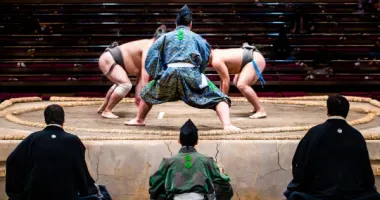Akatsukayama Jorenji 赤塚山 乗蓮寺
The Big Buddha of Tokyo
In the northwest of the capital, in the residential area of Akatsuka in the Itabashi district, there is a small jewel of elegance and tranquility; the Akatsukayama Jorenji watched over by the third largest Daibutsu of the archipelago.
A temple that doesn't stay in place
Located at the top of a small hill, the Akatsukayama Jorenji, unknown to tourists, is nevertheless a small treasure of the Japanese capital. Nestled today on a natural promontory nicknamed Akatsukayama (Akatsuka Mountain), where the estate's castle once stood, the temple has had several distinct locations over the centuries.
Founded during the Yonaga period (1394-1427), it was first established in Yamanaka (present-day Nakamachi area). Tokugawa Ieyasu (1543-1613) recognized it in 1591 as an official temple of the shogunate; making Jorenji a prestigious temple reserved for the Tokugawa . He moved at the beginning of the Edo era (1603-1868) to Nakajuku where he remained until the 1970s. In 1973, road network expansion works and the creation of an expressway pushed the temple to settle on the remains of the ancient castle of Akatsuka.
To read: 10 free tours in Japan
The Judgment of Souls
At the bottom of the stairs leading to Akatsukayama Jorenji, you can, if you feel like it, look at yourself in the mirror of judgment of Enma, the King of the Underworld. The lord of the realm of the dead and judge of souls indeed stands in the Enma-do , on the right side of the enclosure of the Jorenji. Enma is said to decide where souls will be reborn, using her crystal mirror, the jouharikyō , to look at the lives and sins of the deceased. A demonic smile on his lips, he waits for visitors to submit to his judgment . Beside her stands Datsue-ba , literally the "old woman who takes off the clothes".
This old witch from hell, who usually keeps the demon Keneo company on the banks of the Sanzu River, undresses the dead . If a deceased arrives naked in front of Datsue-ba, she flays him alive. Keneo then takes care of hanging the clothes on the branch of a tree whose curvature above the water illustrates the seriousness of sins in the waters of the river. Knowing all this, some visitors will hasten to climb the steps leading to Akatsukayama Jorenji.
See also: Japanese superstitions
The serenity of the 3rd largest Daibutsu
The Jorenji is particularly famous for its Daibutsu or “Big Buddha” with a beautiful black patina. Nicknamed the " Daibutsu of Tokyo", it is the third largest seated Buddha in Japan after those of Todai-ji in Nara and Kôtoku-in in Kamakura. With a total height of 13 meters and weighing 32 tons, it was erected in 1977 to appease the spirits of the victims of the Second World War and the great Kanto earthquake in 1923. Remember that the latter had got the better of the Daibutsu Yama of the park d'Ueno of which only a face enshrined in a frame remains today.
This Daibutsu is also said to watch over the souls of warriors who died during the sieges of Akatsuka Castle; site where the temple now stands.
Other Buddhas in Japan:
The sculpture garden
The temple also houses a tower commemorating the many victims of the great famine of the Tempo era (1830-1844). The latter occurred in 1833 after heavy rains and a harsh winter destroyed much of the crops. In five years, it will cause the death of more than 1,250,000 people. Uncrowded, this temple is a place conducive to walking and strolling. Its pond located just next to the main building and its garden invite you to relax.
Many stone statues including those of the seven deities of happiness (Shichi Fukujin) are scattered around the grounds of Akatsukayama Jorenji. Have fun finding the eight sculptures from the former residence of the Todo clan in Komagome, offered in 1962 and installed since then in the charming garden. These include: Tekkain Sennin, the Japanese adaptation of one of the Taoist Eight Immortals; Monju Bosatsu riding his lion, Datsue-ba, En no Gyōja, the founding ascetic of the Shugendo sect; Gaman no oni, a monstrous demon capable of assuming your worries in exchange for a prayer and finally Hotei, Ebisu and Daikokuten, three deities of the Shichi Fukujin.
Address, timetable & access
Address
Phone
03-3975-3325Timetable
About 20 minutes on foot from Nishi-Takashimadaira (Mita line) and Chikatetsu-Akatsuka (Tobu Tojo line) stationsPrice
FreeAccess
Open all year round from 8 a.m. to 4 p.m. (last entry at 3.45 p.m.).Website
http://www.city.itabashi.tokyo.jp/c_kurashi/003/003913.html













































